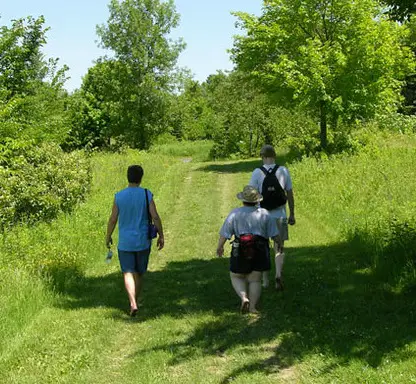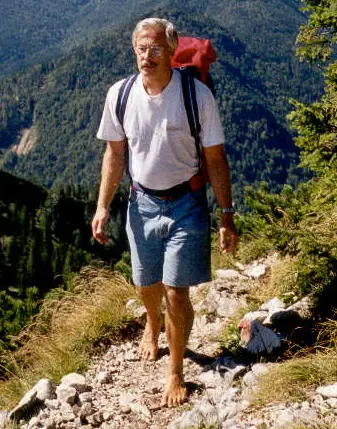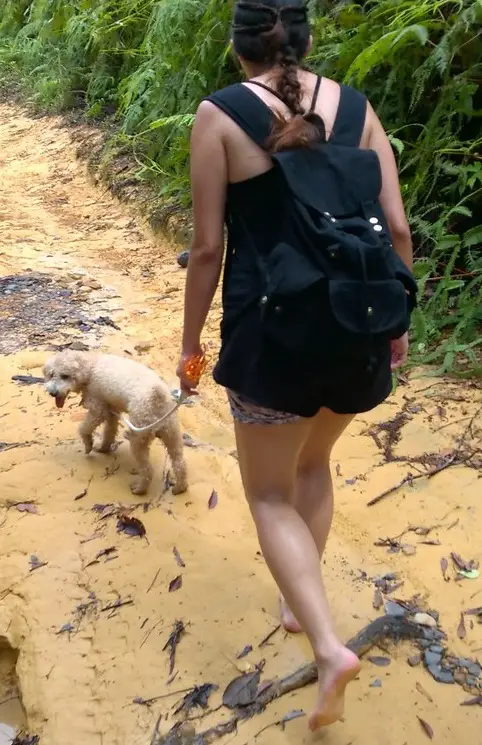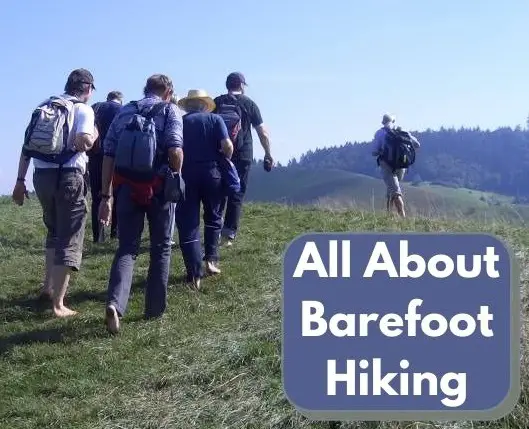With natural ergonomics and posture becoming more of a focus, it seems like everyone’s trying to do things barefoot these days: barefoot running has gained in popularity and people are pushing the benefits big time. What about barefoot hiking though? There are benefits and drawbacks to hiking barefoot for sure, but with a little preparation there’s lots of potential in this natural twist on one of the world’s most popular hobbies.

Pros Of Barefoot Hiking
It’s Better For Your Joints
The increased sensitivity you’ll experience hiking without shoes or boots will reduce your force of impact which decreases the amount of strain put on your joints.
Better Balance And Coordination
Hiking boots can dull the mechanoreceptors on your feet’s muscles and soles, which impacts your balance, coordination, and weight distribution.
Hiking barefoot requires your body to be more responsive to how you load your weight on your feet, improving your balance.
Increased Proprioception
Proprioception, the ability to sense the ground beneath your feet, is increased when barefoot, which will decrease the impact level you step down with.
Lowered impact means less strain on your joints, helping to reduce injury and soreness.
Improved Ergonomics And Posture
Wearing hiking boots doesn’t train your feet to be used the way your body naturally would- they give you more protection and allow you to be a little rougher than you’d be without them.
Barefoot hiking makes you more aware of the force you use when stepping down and requires better posture, which will improve over time.
It’s Totally Natural
There’s a natural contour that your foot grips to the ground when barefoot, and feeling the tactile response of your surroundings on your bare skin can help you better connect to the outdoors.
No-Cost Approach
Considering that hiking boots usually run around $100 and up, hiking barefoot is a no-cost alternative and will save you money.
Reduced Foot Pain And Plantar Fasciitis
Many hiking boots and shoes have narrow toe boxes and overcompensate for arch support, which can misalign your toes over prolonged use.
Your toes also can’t spread normally as they would when barefoot, so your feet will experience pain and fatigue faster in footwear.
Plantar fasciitis, a problem related to stress on the heel and surrounding tissues, is often reduced in part to the increases in foot strength gained by barefoot hiking and walking.
Quicker Drying Time
Rather than waiting for hours to dry out your hiking boots or hiking shoes, bare feet dry very quickly.
Wet shoes can also be a source of blisters or odors, which are of no risk when going barefoot.
No Boots = Less Weight
Considering the fact that every pound on your feet is equivalent to five pounds on your back, ditching the hiking boots will give you more energy and stamina so you can enjoy more time on the trail.
Going Barefoot Strengthens Your Feet & Ankles
Since there’s no heel lift with your bare feet, you’ll be allowing your Achilles tendon and calf muscles to stretch and lengthen more, reducing your chance of injuries.
This also allows the ball of your foot to act as a natural shock absorber, which is what your body naturally intended.
Lastly, hiking barefoot will help you develop a natural gait, strengthening the ligaments, tendons, and muscles in your feet.

Cons Of Hiking Barefoot
Calluses
Although some hikers actively pursue calluses for wearing hiking boots, barefoot hikers general want to avoid them.
While calluses can provide some degree of protection by toughening the skin, calluses can also crack and become painful.
Avoid calluses by taping problem areas as they arise and always moisturizing your feet after hiking while barefoot.
Slipping Potential
Downhill hiking on wet surfaces with bare feet can pose a slipping or falling hazard, so be aware of the trail conditions and any steep declines you’ll need to navigate.
Hiking sticks can be a great addition to your barefoot hiking routine and will help take the load off your feet, too.
Barefoot Hiking Takes Longer
Generally speaking, your average hiking speed when barefoot is going to be slower than when you’re wearing hiking boots.
Factor this into your planning when deciding when to start or estimating the end of your hikes.
Your Focus Is Always On Your Feet
Sometimes you can miss out on the views or scenery because you’re always looking where you’re putting your next step.
Transition Time
It’s going to take some time to get your feet used to hiking when barefoot.
Starting to hike while wearing barefoot and minimalist hiking boots or barefoot hiking shoes will take extra time but can be a great way to get your feet used to the sensation of hiking barefoot without taking the full-on plunge while your feet adapt.
Dangers Of Barefoot Hiking
Plants
Poison ivy, posion oak, nettle, thistle, and thorns are all valid concerns as they can come in contact with your bare feet on the trail and cause pain from the thorns or oils they have.
Animals & Insects
Stepping on or near stinging and/or biting insects and animals like mosquitoes, spiders, snakes, chiggers, ants, and scorpions while on the trail is a real possibility, so you need to always watch your step.
A bite or sting can end with lots of pain and having to cut your hiking trip short.
Splinters & Foreign Objects
Discarded items from other hikers and things like glass or other debris can puncture the soles of your feet.
Make sure you apply less downward pressure when walking to avoid this as much as possible, and always carry a pair of tweezers in your hiking first aid kit.
Injuries
Cut feet, stubbed or broken toes, black toenails, and burned soles are all very possible injuries that can occur when you hike barefoot.
Infections
If you step on rusty nails or other metal scraps you risk tetanus, and otherwise there are some other types of bacteria not native to your home where you can pick something up while barefoot on the trail.

How To Start Hiking Barefoot
Transition To Barefoot Hiking Boots Or Barefoot Hiking Shoes First
Many hikers who want to go fully barefoot first spend some time on the trail in minimalist hiking boots, barefoot hiking shoes, or even toe shoes for hiking.
These all provide a good middle ground that will help to train your feet to be more sensitive and have a natural or barefoot feel while still offering key protection that your feet need.
Prepare Your Feet For Hiking
There are some exercises and treatments you can do to get your feet ready – check out our guide on how to prepare your feet for hiking for some helpful tips.
Start Out Slow
Start by trying out walking on different surfaces and textures in your yard and around your home, gradually increasing the total amount of time you go barefoot for each outing.
Practice Stepping Straight Down
Be mindful about kicking, dragging, or shuffling your feet along the ground, as this can leave you open to barefoot hiking injuries.
Also start practicing lifting your foot straight up in the air before each step rather than kicking it forward, which will help prevent stubbing your toes on rocks or roots.
Pick Familiar Trails
Try out your first few barefoot hikes on trails you know well – at least that way you know the general terrain and can spend more time focused on your next step rather than worrying about missing the scenery.
Keep Your Eye On The Path
If you want to admire nature, stop and look around – don’t do it while moving if you’re barefoot.
Hiking barefoot takes skill and vigilance, as you always need to look where you’re stepping and keeping an eye on the path ahead of you.
Bring A First Aid Kit
Throw a first aid kit in your day pack in case you run into any trouble, and bring along some Moleskin tape, Leukotape, or Rock Tape while you’re at it just in case.
Know When Not To Hike Without Boots
If you know the trail is going to have sharp jagged rocks, biting or stinging insects, or you could be encountering inclimate weather, sometimes it’s best to put your pride aside and just wear some regular hiking boots.
Have A Backup Plan Just In Case
Bring along a pair of hiking boots, hiking shoes, or even some hiking sandals as a backup in case your feet start to get sore or injured so you can finish the rest of your hike in your backup footwear.
It’s always smart to have another option available.
More Barefoot Hiking Resources
Barefoot Hiking Books
Born To Run – Christopher McDougall

McDougall makes the case for the best shoes being no shoes at all in this in-depth analysis on bare feet and how running without shoes is beneficial in many ways.
The Barefoot Hiker – Richard Frazine

Published in 1993, The Barefoot Hiker is considered to be an excellent resource on all things barefoot including a historical and cultural analysis as well as a great how-to manual on hiking barefoot.
The Barefoot Book – Daniel Howell, PhD.

The Barefoot Book outlines all the reasons why going barefoot is much more beneficial for us than wearing shoes, and he makes a very convincing argument.
Online Communities
The Society For Barefoot Living, Reddit’s Thread On Local Barefoot Hiking Groups, and MeetUp Barefoot Hiking Groups are all great ways to connect with others locally and across the globe to share your experiences and tips.
FAQs About Hiking Barefoot
Bring everything you usually would (snacks, sunblock, bug spray, plenty of water) along with a pair of boots, shoes, or sandals just to be safe.
Most trails do not have any rules against hiking barefoot. Check with your local trail or park ranger ahead of time to be certain.
You should always bring a pair of hiking boots, hiking shoes, or hiking sandals when hiking barefoot as a backup in case of injury or soreness.

